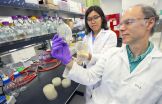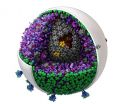Sweet smell of success
JBEI researchers boost methyl ketone production in e. coli
2014-12-01
(Press-News.org) Two years ago, researchers at the U.S. Department of Energy's Joint BioEnergy Institute (JBEI) engineered Escherichia coli (E. coli) bacteria to convert glucose into significant quantities of methyl ketones, a class of chemical compounds primarily used for fragrances and flavors, but highly promising as clean, green and renewable blending agents for diesel fuel. Now, after further genetic modifications, they have managed to dramatically boost the E.coli's methyl ketone production 160-fold.
"We're encouraged that we could make such a large improvement in methyl ketone production with a relatively small number of genetic modifications," says Harry Beller, a JBEI microbiologist who led this study. "We believe we can further improve production using the knowledge gained from in vitro studies of our novel metabolic pathway."
Beller, who directs the Biofuels Pathways department for JBEI's Fuels Synthesis Division, and is also a senior scientist with Berkeley Lab's Earth Sciences Division, is the corresponding author of a paper describing this work in the journal Metabolic Engineering. The paper is titled "Substantial improvements in methyl ketone production in E. coli and insights on the pathway from in vitro studies." Co-authors are Ee-Been Goh, Edward Baidoo, Helcio Burd, Taek Soon Lee and Jay Keasling.
Methyl ketones are naturally occurring compounds discovered more than a century ago in the aromatic evergreen plant known as rue. Since then they've been found to be common in tomatoes and other plants, as well as insects and microorganisms. Today they are used to provide scents in essential oils and flavoring in cheese and other dairy products. Although native E. coli make virtually undetectable quantities of methyl ketones, Beller, co-author Goh and their colleagues have been able to overcome this deficiency using the tools of synthetic biology.
"In our original effort, for methyl ketone production we made two major modifications to E. coli," Beller says. "First we modified specific steps in beta-oxidation, the metabolic pathway that E. coli uses to break down fatty acids, and then we increased the expression of a native E. coli enzyme called FadM. These two modifications combined to greatly enhance the production of methyl ketones."
In their latest effort, Beller, Goh and their colleagues made further modifications that included balancing the overexpression of two other E. coli enzymes, fadR and fadD, to increase fatty acid flux into the pathway; consolidating two plasmid pathways into one; optimizing codon usage for pathway genes not native to E. coli; and knocking out key acetate production pathways. The results led to a methyl ketone titer of 3.4 grams/liter after approximately 45 hours of fed-batch fermentation with glucose. This is about 40-percent of the maximum theoretical yield for methyl ketones.
"Although the improved production is still not at a commercial level in the biofuel market, it is near a commercial level for use in flavor and fragrances, where certain methyl ketones are much more highly valued than they would be in the biofuel market," Beller says. "It may be possible for a company to sell a small percentage of methyl ketones in the flavor and fragrance market and use the profits to enhance the economic viability of the production of methyl ketones as biofuels."
The in vitro studies carried out by Beller and Goh provided insights into the pathway, some of which point to even further production gains. One key finding was the confirmation that a decarboxylase enzyme is not required for this methyl ketone pathway.
"Several different metabolic pathways have been developed in the past couple of years for methyl ketone production in E. coli, a couple of which use decarboxylase enzymes to catalyze the last step of the pathway," Beller says. "Our methyl ketone pathway is performing quite a bit better than these other pathways, but it does not include a native or added decarboxylase."
The in vitro studies also addressed concerns about the FadM enzyme being somewhat "promiscuous" in its hydrolyzing (thioesterase) activities. Beller and Goh found that FadM can act on intermediates in the methyl ketone pathway and effectively reduce the flux of carbon to the final methyl ketone products. However, they say that with some informed metabolic engineering, this need not be a problem and knowledge of the phenomenon could even be used to enhance production.
"In all likelihood, there is a sweet spot in the level of expression of the FadM enzyme that will allow for maximal production of methyl ketones without siphoning away metabolic intermediates," Beller says.
INFORMATION:
This research was supported by JBEI through the U.S. Department of Energy's Office of Science.
JBEI is one of three Bioenergy Research Centers established by the DOE's Office of Science in 2007. It is a scientific partnership led by Berkeley Lab and includes the Sandia National Laboratories, the University of California campuses of Berkeley and Davis, the Carnegie Institution for Science, and the Lawrence Livermore National Laboratory. DOE's Bioenergy Research Centers support multidisciplinary, multi-institutional research teams pursuing the fundamental scientific breakthroughs needed to make production of cellulosic biofuels, or biofuels from nonfood plant fiber, cost-effective on a national scale.
Lawrence Berkeley National Laboratory addresses the world's most urgent scientific challenges by advancing sustainable energy, protecting human health, creating new materials, and revealing the origin and fate of the universe. Founded in 1931, Berkeley Lab's scientific expertise has been recognized with 13 Nobel prizes. The University of California manages Berkeley Lab for the U.S. Department of Energy's Office of Science. For more, visit http://www.lbl.gov.
[Attachments] See images for this press release:


ELSE PRESS RELEASES FROM THIS DATE:
2014-12-01
In a remarkable collaborative effort between human and veterinary clinicians, a 29-year-old bottlenose dolphin recently underwent therapeutic bronchoscopy to treat airway narrowing, or stenosis, that was interfering with her breathing. The dolphin, a therapy animal for mentally and physically challenged children at Island Dolphin Care in Key Largo, Florida, is doing well one year after the procedure.
"Many of the medical treatments and procedures used in humans were developed and tested in animals, and many are used in the care of both," said lead author Andrew R. Haas, ...
2014-12-01
MADISON, Wis. -- In 1997, IBM's Deep Blue computer beat chess wizard Garry Kasparov. This year, a computer system developed at the University of Wisconsin-Madison equaled or bested scientists at the complex task of extracting data from scientific publications and placing it in a database that catalogs the results of tens of thousands of individual studies.
"We demonstrated that the system was no worse than people on all the things we measured, and it was better in some categories," says Christopher Ré, who guided the software development for a project while a UW ...
2014-12-01
MADISON, Wis. -- If Brad Singer knew for sure what was happening three miles under an odd-shaped lake in the Andes, he might be less eager to spend a good part of his career investigating a volcanic field that has erupted 36 times during the last 25,000 years. As he leads a large scientific team exploring a region in the Andes called Laguna del Maule, Singer hopes the area remains quiet.
But the primary reason to expend so much effort on this area boils down to one fact: The rate of uplift is among the highest ever observed by satellite measurement for a volcano that ...
2014-12-01
ANN ARBOR--As much as two-thirds of Earth's carbon may be hidden in the inner core, making it the planet's largest carbon reservoir, according to a new model that even its backers acknowledge is "provocative and speculative."
In a paper scheduled for online publication in the Proceedings of the National Academy of Sciences this week, University of Michigan researchers and their colleagues suggest that iron carbide, Fe7C3, provides a good match for the density and sound velocities of Earth's inner core under the relevant conditions.
The model, if correct, could help ...
2014-12-01
LA JOLLA, CA - December 1, 2014 - Researchers can now explore viruses, bacteria and components of the human body in more detail than ever before with software developed at The Scripps Research Institute (TSRI).
In a study published December 1 in the journal Nature Methods, the researchers demonstrated how the software, called cellPACK, can be used to model viruses such as HIV.
"We hope to ultimately increase scientists' ability to target any disease," said Art Olson, professor and Anderson Research Chair at TSRI who is senior author of the new study.
Putting cellPACK ...
2014-12-01
MADISON, Wis. - In 1997, IBM's Deep Blue computer beat chess wizard Gary Kasparov. This year, a computer system developed at the University of Wisconsin-Madison achieved something far more complex. It equaled or bested scientists at the complex task of extracting data from scientific publications and placing it in a database that catalogs the results of tens of thousands of individual studies.
"We demonstrated that the system was no worse than people on all the things we measured, and it was better in some categories," says Christopher Ré, who guided the software ...
2014-12-01
LEXINGTON, KY. (Dec. 1, 2014) -- A group of physiologists led by University of Kentucky's Tim McClintock have identified the receptors activated by two odors using a new method that tracks responses to smells in live mice.
Their research was published in the latest edition of The Journal of Neuroscience.
Using a fluorescent protein to mark nerve cells activated by odors, McClintock and his coworkers identified the receptors that allow mouse nerve cells to respond to two odors: eugenol, which is a component of several spices, most notably cloves, and muscone, known ...
2014-12-01
When people hear about the dangers of the ozone hole, they often think of sunburns and associated health risks, but new research shows that ozone depletion changes atmospheric and oceanic circulation with potentially devastating effects on weather in the Southern Hemisphere weather.
These could include increased incidence of extreme events, resulting in costly floods, drought, wildfires, and serious environmental damage. The ecosystem impacts documented so far include changes to growth rates of South American and New Zealand trees, decreased growth of Antarctic mosses, ...
2014-12-01
Inundation of nitrogen into the atmosphere and terrestrial environments, through fossil fuel combustion and extensive fertilization, has risen tenfold since preindustrial times according to research published in Global Biogeochemical Cycles. Excess nitrogen can infiltrate water tables and can trigger extensive algal blooms that deplete aquatic environments of oxygen, among other damaging effects.
Although scientists have extensively studied the effects of excess nitrogen in terrestrial habitats, the effect on the open ocean remains unknown. Altieri et al. point out that ...
2014-12-01
Through research in mice, scientists have found that proteins at the blood-brain barrier pump out riluzole, the only FDA-approved drug for ALS, or Lou Gehrig's disease, limiting the drug's effectiveness. However, when the investigators blocked these proteins, the effectiveness of riluzole increased and the animals experienced improved muscle function, slower disease progression, and prolonged survival.
The findings suggest that blocking these transporter proteins at the blood-brain barrier might improve delivery, and ultimately, efficacy, of drugs used to treat ALS and ...
LAST 30 PRESS RELEASES:
[Press-News.org] Sweet smell of success
JBEI researchers boost methyl ketone production in e. coli


